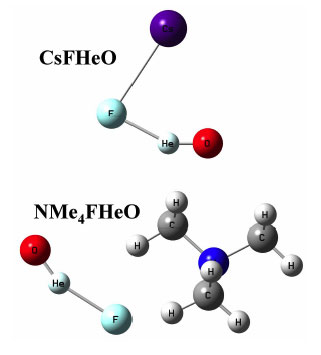| Posted: November 23, 2008 |
Chemist predicts collapse of helium's chemical nobility |
|
(Nanowerk News) 140 years since its discovery, and despite the best endeavours of many scientists,
helium, the lightest of the ‘noble’ gases, still stubbornly refuses to enter into any
chemical alliance. Now a new glimmer of hope has emerged from Poland as a chemist
at the University of Warsaw has calculated that two new compounds containing a
helium-oxygen bond could be formed.
|
|
Considered to be the smallest, most chemically inert and least polarizable of the 117
known chemical elements, helium has been challenging chemists for generations.
Unfortunately, no-one has managed to confirm experimentally the existence of either
HeBeO1 or HHeF2, two important species previously predicted, nor a number of others.
|
 |
| Models of two hypothetical species containing helium chemically bound to oxygen
|
|
The two new molecular species to bind helium to oxygen, predicted using theory,
CsFHeO and NMe4FHeO, are derivatives of a metastable [F– HeO] anion first
theorized in 2005 by a group from Taiwan led by Prof. Hu.
|
|
The scientist responsible for
performing these new quantum chemical calculations is Dr Wojciech Grochala from
ICM and the Faculty of Chemistry, the University of Warsaw.
|
|
Speaking of his results,
Dr Grochala said, “The molecules are not as peculiar as they
might appear at first light; the idea is to preserve the
metastable character of the fragile [F– HeO] entity by
attaching it to a weakly coordinating cation (such as Cs+ or
NMe4
+) to achieve electric neutrality. The resulting species
exhibit a He–O bond with an electronic dissociation energy on
the singlet potential energy surface (PES) as large as half an
eV for the tetramethylammonium derivative.”
|
|
Unfortunately,
the kinetic stability of the molecules in question is limited by a
crossing of the singlet–triplet PESs and additionally by facile
decomposition along the bending channel, both factors
considerably limiting their lifetime.
|
|
The implication for a realworld
search for these molecules is that they should be
sought at a temperature of a few kelvin at most.
|
|
Commenting
on how this could be achieved, Dr Grochala said, “The
synthesis of both species might begin with the unusual
hypofluorites, CsOF and NMe4OF, embedded in an ultracold
helium droplet. Laser excitation of the O–F chemical bond should allow for insertion of a helium atom into
the bond and for spectroscopic observation of the short– living molecules. Of course, such experiments are
quite challenging but this is what makes modern chemistry so much fun”. He added, “Despite various difficulties
I am really excited about the predictions”.
|
|
The results will be published in the Jan 2009 issue of Polish Journal of Chemistry and presented during the New Chemistry of the Elements Symposium of The Royal Society of Chemistry in London
(11–12 Dec 2008).
|

